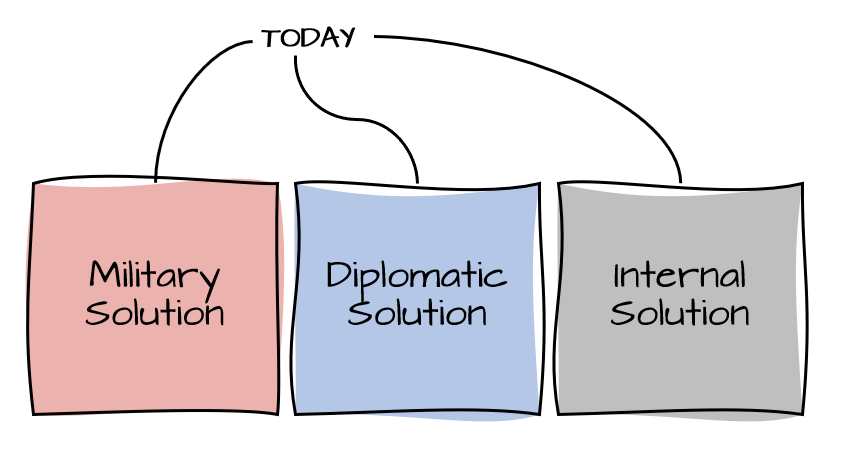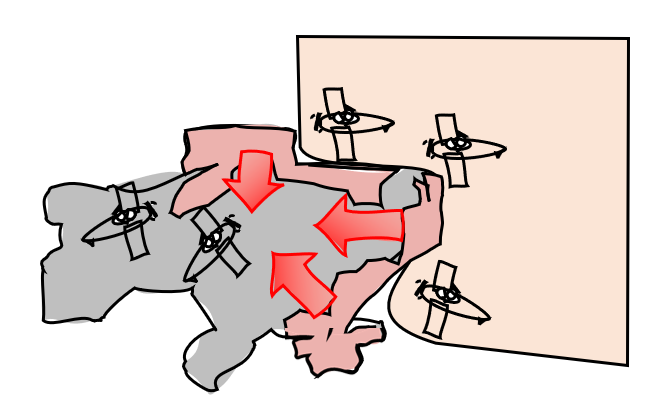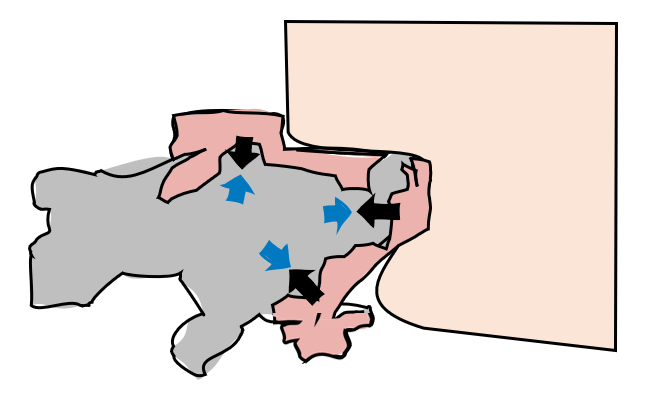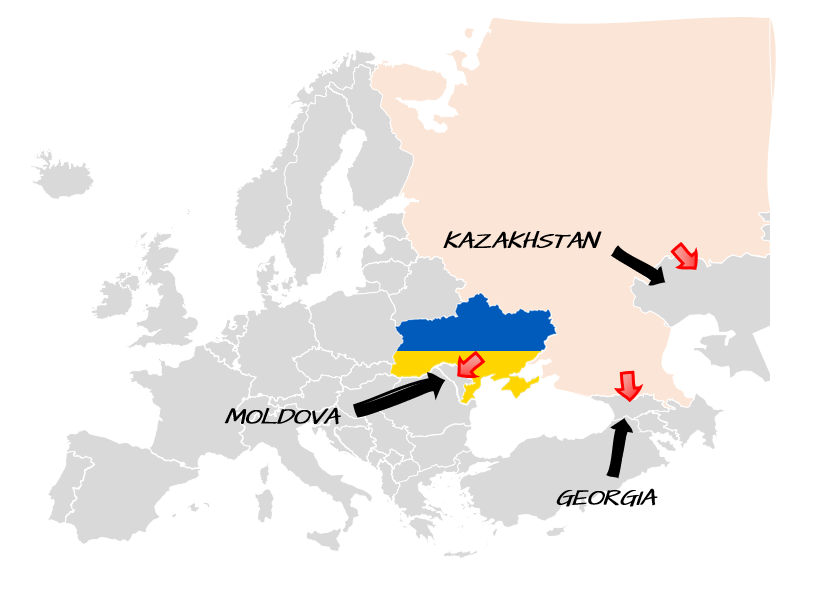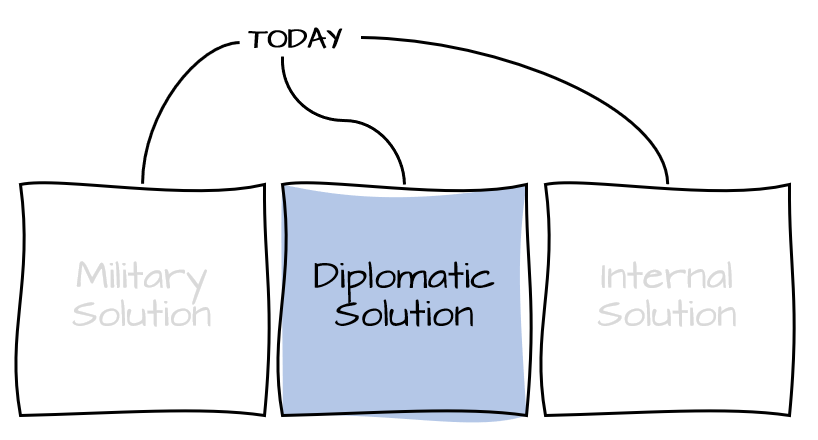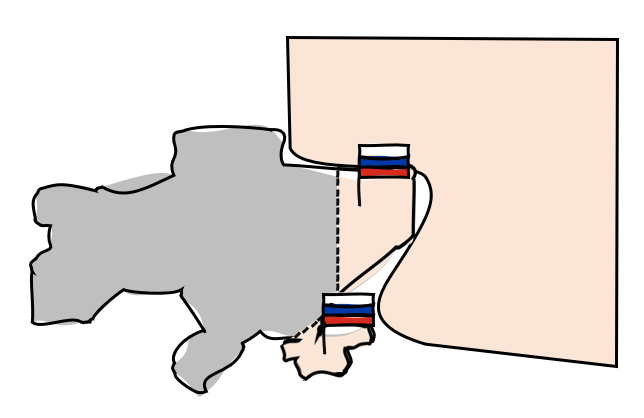So what’s happening Ukraine? Part 5: What comes next?
This is the fifth and final post in a series about the situation in Ukraine; they are chronological, so if you are just joining us, I’d start here: Part 1: How did we get here?
This series is not meant to be a definitive history, nor a comprehensive analysis of the conflict or either country. The goal is to help simplify a complex and important topic and provide readers with a baseline appreciation for the situation.
In the last piece we covered everything we knew so far about the attack, and the resistance, up until March 13th. In this piece we’ll attempt to map out potential end-game scenarios.
The idea of predicting the future is a scary one. We’re also in absolutely no position to do so. But here we go nonetheless!
If we simplify the options that are on the table, there are roughly three types of solutions that the situation in Ukraine could conclude with.
MILITARY SOLUTION
Let’s start with the military solution, because it’s the most unpleasant.
The military solution itself has 3 potential sub-scenarios to break down.
Short war
One way this war could run short is if Ukraine pushes Russia back. This is an unlikely scenario. The sheer power imbalance between the two nations, and the face-losing repercussions of defeat for Putin would make this a very difficult scenario.
Dare to dream.
This second scenario in which the war could run short would require Russia to significantly escalate its military operations, ratcheting up artillery attacks, air strikes, and cyber-warfare to overwhelm Ukraine.
This approach would rapidly create grim outcomes, as major Ukrainian cities would need to fall within weeks.
Zelenskyy would be deposed (at best), likely setting up a government in exile much like France in WWII. A pro-Russian leader would be put in his place.
This would create a very unstable outcome, as the new pro-Russian government would be considered illegitimate and prone to repeated conflict.
Long war
This scenario would see Russian forces stuck in their advance, and unable to take Kyiv for a long period of time due to strong Ukrainian resistance.
This could result in long sieges of hold-out Ukrainian cities, and difficult house-to-house advances.
In this scenario, support could continue to flow in from the West propping up Ukrainian fighters who would continue to make it difficult for Russian invaders to advance. Sanctions would also continue to negatively impact Russia, causing suffering on both sides of the disputed border.
Eventually the advance would succeed, but it may feel like a pyrrhic victory, and like the previous example be vulnerable to highly-motivated domestic insurgency.
Perhaps after many years, new Russian leadership would eventually leave Ukraine bruised and bloodied, not unlike they did in Afghanistan in the 80s.
Larger war
This is certainly a worst case scenario.
It is possible for the war to spill beyond the borders of Ukraine, if Putin were to use the same logic to wage additional wars in other ex-Soviet republics like Moldova, Georgia, and Kazakhstan.
This would be very bad. But it could still get worse.
Theoretically, a war with NATO is still in the cards.
Russia has already declared that Western arms supplies to Ukraine are an act of aggression and threatened to blow up convoys carrying such equipment. There are other defensive / offensive maneuvers that Putin may consider, many of which would trigger “Article 5” in the NATO’s alliance agreement.
This scenario is far less likely, as any direct moves against NATO would put Russia immediately into a war with most of Europe, the USA, Canada, and the U.K.
The absolute worst-case scenario in this scenario is the Pandora’s Box that is the nuclear option, but it is extremely unlikely so we aren’t going to go there.
DIPLOMATIC SOLUTION
Now that we’ve covered off the least palatable options, let’s look at a potential diplomatic solution.
Despite the apparent disregard for diplomacy that Putin has shown during the early parts of this crisis, there may still be some avenues back to the negotiating table to end this invasion through diplomacy.
During the last few weeks there have been several attempts at diplomacy. French and German leaders have held phone calls with Putin to try and talk him down for his aggression, and Ukrainian and Russian officials have met for talks twice on the border of Belarus. Putin has also signaled that he would accept Israel as a potential host to further high-level talks.
While these efforts so far have not amounted to much, the fact that Putin has been willing to entertain them signals that diplomacy may not be completely off the table for him.
The critical question is whether Western leaders would be able to offer him enough to save-face and call off the invasion. One hypothetical scenario may see a prolonged, bloody conflict in Ukraine that does not have any decisive victor in either direction. Perhaps both Russia and Ukraine are tired of the bloodshed and agree to end the fighting. In exchange for recognition of Crimea as Russia and the DPR and LDR as independent, Russia may accept Ukraine’s sovereignty and its right to deepen ties with Europe and the West.
INTERNAL SOLUTION
With a constantly decreasing quality of life at home and a steady flow of body-bags coming back from Ukraine, Putin may be at risk of losing his popular support.
In this scenario, the economic sanctions have had such a devastating effect on the Russian economy that the Russian people themselves decide to revolt against Putin’s regime.
At present, he uses the domestic law enforcement and security forces to oppress protestors. Also in his employ are state-sponsored news channels that continuously inject his agenda into public information. Perhaps after enough time and hardship, influential members of Russia’s military, political and economic elite decide to turn against him, removing him from office and replacing him with a leader who is motivated to restore normal diplomatic relations and the lifting of sanctions.
This situation is plausible, but it is certainly a wild-card.
It is important to reiterate that these scenarios are purely speculative and certainly not MECE. It is possible that the real outcome is some combination of the above, or something completely unexpected.
One thing that is for certain is that the world has changed. It will not return to the same status quo as before, especially for Russia. Their relationship with the outside world is changed irrevocably. Europe’s attitude towards collective security is also likely forever altered. Perhaps the EU itself might try to make their own army for collective defense. More classically neutral and ex-Soviet countries will be drawn towards the protection of NATO. Finally, the liberal, rules-based international order may have rediscovered why it existed in the first place (to prevent major wars). While it is difficult to envision, perhaps an event like this might spur reform in international institutions like the UN, so that great powers are no longer able to act with impunity.
If there is one “upside” to this horror and the corresponding shift in geopolitics, it is that the strong, unified opposition of the liberal-democratic world to the invasion of a sovereign independent nation may act as a deterrent for future authoritarian dictators who have similar dreams of conquest and expansion.
Did this series help you better understand the conflict in Ukraine? Share below!

